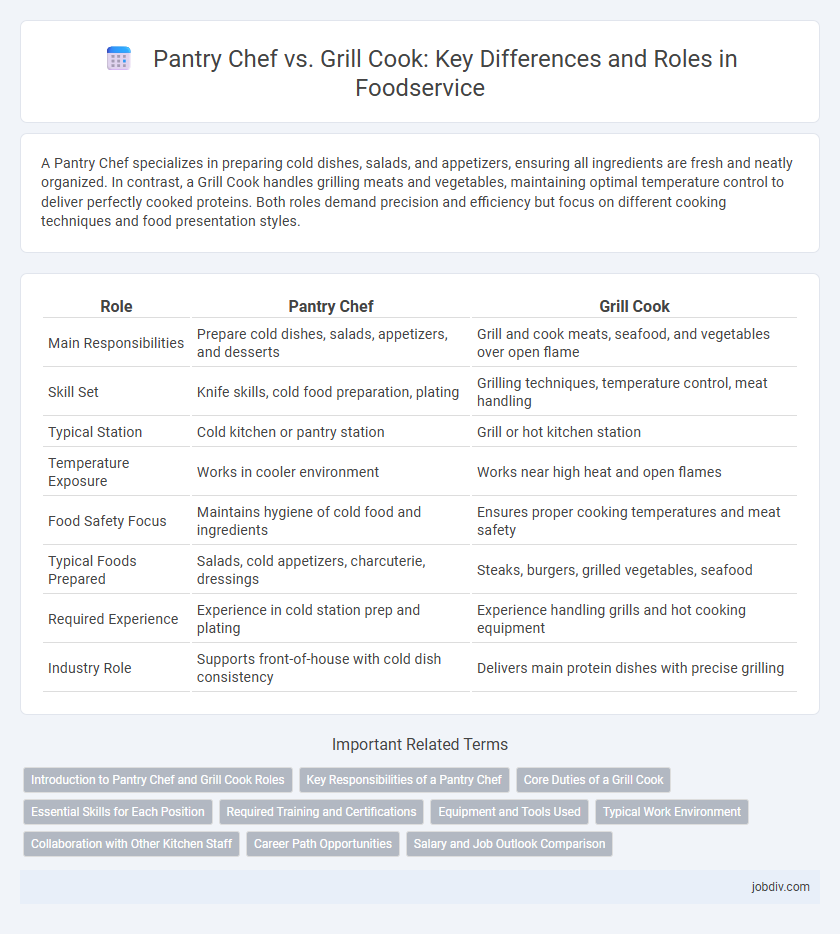A Pantry Chef specializes in preparing cold dishes, salads, and appetizers, ensuring all ingredients are fresh and neatly organized. In contrast, a Grill Cook handles grilling meats and vegetables, maintaining optimal temperature control to deliver perfectly cooked proteins. Both roles demand precision and efficiency but focus on different cooking techniques and food presentation styles.
Table of Comparison
| Role | Pantry Chef | Grill Cook |
|---|---|---|
| Main Responsibilities | Prepare cold dishes, salads, appetizers, and desserts | Grill and cook meats, seafood, and vegetables over open flame |
| Skill Set | Knife skills, cold food preparation, plating | Grilling techniques, temperature control, meat handling |
| Typical Station | Cold kitchen or pantry station | Grill or hot kitchen station |
| Temperature Exposure | Works in cooler environment | Works near high heat and open flames |
| Food Safety Focus | Maintains hygiene of cold food and ingredients | Ensures proper cooking temperatures and meat safety |
| Typical Foods Prepared | Salads, cold appetizers, charcuterie, dressings | Steaks, burgers, grilled vegetables, seafood |
| Required Experience | Experience in cold station prep and plating | Experience handling grills and hot cooking equipment |
| Industry Role | Supports front-of-house with cold dish consistency | Delivers main protein dishes with precise grilling |
Introduction to Pantry Chef and Grill Cook Roles
A Pantry Chef specializes in preparing cold dishes, salads, and appetizers, ensuring freshness and proper presentation within a foodservice kitchen. Grill Cooks focus on cooking meats, seafood, and vegetables over high-heat grills, maintaining precise timing and temperature control for quality. Both roles are essential in delivering seamless service and diverse menu offerings in professional kitchens.
Key Responsibilities of a Pantry Chef
A Pantry Chef is responsible for preparing cold dishes, including salads, appetizers, and desserts, ensuring freshness and presentation quality. They manage inventory for perishable ingredients, maintain hygiene standards, and assist with menu planning related to cold food items. Unlike Grill Cooks who focus on grilling meats and hot dishes, Pantry Chefs specialize in precise knife skills and balanced flavor combinations.
Core Duties of a Grill Cook
A Grill Cook specializes in preparing grilled and broiled foods, ensuring precise cooking temperatures and timing to achieve optimal flavor and texture. Core duties include seasoning meats, fish, and vegetables, monitoring grill equipment safety, and maintaining cleanliness to comply with health regulations. Unlike a Pantry Chef who handles cold food preparation and salads, the Grill Cook focuses on hot food production and direct heat cooking methods.
Essential Skills for Each Position
Pantry chefs excel in knife skills, ingredient preparation, and maintaining cold food quality, ensuring efficient mise en place and hygiene standards. Grill cooks specialize in temperature control, timing, and seasoning to deliver perfectly cooked meats and grilled dishes. Both roles require strong multitasking abilities and knowledge of food safety regulations to maintain seamless kitchen operations.
Required Training and Certifications
Pantry chefs typically require foundational culinary training focused on cold food preparation and food safety certifications such as ServSafe to handle perishable ingredients properly. Grill cooks benefit from specialized training in grilling techniques, temperature control, and often need certifications related to fire safety and food hygiene. Both positions emphasize hands-on experience, but grill cooks may require additional training in high-heat cooking equipment operation.
Equipment and Tools Used
Pantry chefs primarily utilize cold prep equipment such as refrigerated prep tables, mandolines, slicers, and mixing bowls to handle salads, dressings, and cold dishes. Grill cooks rely heavily on high-heat tools including commercial grills, charbroilers, spatulas, tongs, and heat-resistant gloves to sear and cook meats and vegetables efficiently. Both roles require knife sets but differ significantly in specialized equipment suited to their respective cooking environments.
Typical Work Environment
Pantry chefs typically work in cold kitchen areas such as salad stations, preparing appetizers and chilled dishes in fast-paced, temperature-controlled environments. Grill cooks operate near high-heat grills or broilers, managing sizzling stations that require stamina and careful timing to handle meats and other grilled items safely. Both roles demand organized workspaces but differ significantly in temperature, equipment, and immediate job pressures within foodservice kitchens.
Collaboration with Other Kitchen Staff
Pantry chefs and grill cooks collaborate closely to ensure efficient kitchen operations and timely meal delivery. Pantry chefs prepare cold dishes, sauces, and salads, coordinating with grill cooks who handle hot entrees and grilled items for a seamless service flow. Clear communication between these roles enhances order accuracy and maintains consistent food quality during peak hours.
Career Path Opportunities
Pantry chefs develop expertise in cold food preparation, gaining skills valuable for roles in garde manger or sous chef positions, which often serve as stepping stones to executive chef careers. Grill cooks specialize in high-heat cooking techniques, positioning themselves for advancement into line cook supervisor or kitchen manager roles in steakhouse or barbecue-focused establishments. Both career paths offer growth through specialized culinary skills, with pantry chefs emphasizing precision and presentation, while grill cooks focus on timing and flavor mastery.
Salary and Job Outlook Comparison
Pantry chefs typically earn an average salary ranging from $25,000 to $35,000 annually, with steady demand in catering and bakery sectors due to consistent need for cold food preparation. Grill cooks have a slightly higher average salary, between $28,000 and $38,000 per year, benefiting from strong job growth in casual dining and fast-casual restaurants where grilling skills are essential. Job outlook for grill cooks is projected to grow by 6% over the next decade, compared to a 4% growth rate for pantry chefs, reflecting greater versatility and demand within diverse culinary settings.
Pantry Chef vs Grill Cook Infographic

 jobdiv.com
jobdiv.com